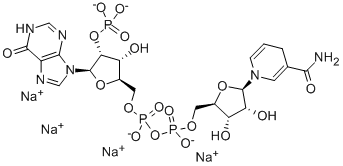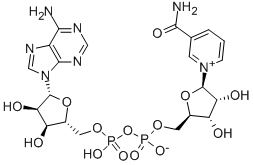β-NADPH;β-Nicotinamide adenine dinucleotide 2′-phosphate reduced tetrasodium salt hydrate?;2′-NADPH hydrate, Coenzyme II reduced tetrasodium salt;NADPH Na4;TPNH2 Na4;Triphosphopyridine nucleotide reduced tetrasodium salt;Dihydronicotinamide adenine dinucleotide phosphate tetrasodium salt , BR.97% , 42934-87-2
CAS NO.:42934-87-2
Empirical Formula: C21H29N6O18P3
Molecular Weight: 746.41
MDL number: MFCD00057028
| Pack Size | Price | Stock | Quantity |
| 25mg | RMB56.00 | In Stock |
|
| 100mg | RMB200.00 | In Stock |
|
| 500mg | RMB880.00 | In Stock |
|
| others | Enquire |
PRODUCT Properties
| Density | 2.28±0.1 g/cm3(Predicted) |
| storage temp. | −20°C |
| pka | 1.13±0.50(Predicted) |
Description and Uses
Nicotinamide hypoxanthine dinucleotide phosphate reduced tetrasodium salt functions as an important cofactor in a variety of metabolic and biosynthetic pathways. Nicotinamide hypoxanthine dinucleotide phosphate reduced tetrasodium salt plays a vital role in the biosynthesis of agents, chiral alcohols, fatty acids and biopolymers, while also being required for lipid biosynthesis, biomass formation, and cell replication. The demand for NADPH tetrasodium salt is particularly high in proliferating cancer cells, where it acts as a cofactor for the synthesis of nucleotides, proteins, and fatty acids. Nicotinamide hypoxanthine dinucleotide phosphate reduced tetrasodium salt is also essential for the neutralization of the dangerously high levels of reactive oxygen species (ROS) generated by increased metabolic activity. NADPH tetrasodium salt is an endogenous inhibitor of ferroptosis.
Deamino-NADPH is a 2'-phosphorylated coenzyme. Deamino-NADPH can be used in ammonia determination[1].
Safety
| Symbol(GHS) |  GHS06 |
| Signal word | Danger |
| Hazard statements | H301-H319-H315-H331-H335-H311 |
| Precautionary statements | P264-P280-P302+P352-P321-P332+P313-P362-P261-P271-P304+P340-P311-P321-P403+P233-P405-P501-P264-P280-P305+P351+P338-P337+P313P-P264-P270-P301+P310-P321-P330-P405-P501-P280-P302+P352-P312-P322-P361-P363-P405-P501 |
| Hazard Codes | T |
| Risk Statements | 23/24/25-36/37/38 |
| Safety Statements | 22-26-36-45 |
| WGK Germany | 3 |



